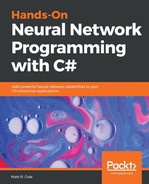Let's take a look at our first example. This is a minimal example in which we will define a two-layer neural network and train it on a single data point. We are intentionally making this example verbose so that we can walk through each step together to improve our understanding:
var net = new Net<double>();
The InputLayer variable declares size of input. As shown in the preceding code, we use two-dimensional data. Three-dimensional volumes (width, height, and depth) are required, but if you're not dealing with images then we can leave the first two dimensions (width and height) at a size of 1, as we have done in the following example:
net.AddLayer(new InputLayer(1, 1, 2));
Declare a fully-connected layer comprising 20 neurons, as follows:
net.AddLayer(new FullyConnLayer(20));
Next, we need to declare a Rectified Linear Unit non-linearity (ReLU) layer, as follows:
net.AddLayer(new ReluLayer());
Then, declare a fully-connected layer that will be used by the SoftmaxLayer with the following code:
net.AddLayer(new FullyConnLayer(10));
Declare the linear classifier on top of the previous hidden layer, as follows:
net.AddLayer(new SoftmaxLayer(10));
var x = BuilderInstance.Volume.From(new[] { 0.3, -0.5 }, new Shape(2));
We then need to move forward with a random data point through the network, as follows:
var prob = net.Forward(x);
prob is a volume. Volumes have property weights that store the raw data, and weight gradients that store gradients. The following code prints approximately 0.50101, as follows:
Console.WriteLine("probability that x is class 0: " + prob.Get(0));
Next, we need to train the network, specifying that x is class zero and using a stochastic gradient descent trainer, shown as follows:
var trainer = new SgdTrainer(net)
{
LearningRate = 0.01, L2Decay = 0.001
};
trainer.Train(x,BuilderInstance.Volume.From(new[]{ 1.0, 0.0, 0.0, 0.0, 0.0, 0.0, 0.0, 0.0, 0.0, 0.0 }, new Shape(1, 1, 10, 1)));
var prob2 = net.Forward(x);
Console.WriteLine("probability that x is class 0: " + prob2.Get(0));
The output should now be 0.50374, which is slightly higher than the previous value of 0.50101. This is because the network weights have been adjusted by the trainer to give a higher probability to the class we trained the network with (which was zero).
